Latent Dirichlet Allocation
1
%matplotlib inline
1
2
3
4
import numpy as np
import scipy as sp
import matplotlib.pyplot as plt
import seaborn as sns
1
2
sns.set_style("ticks")
sns.set_context("talk", font_scale=2, rc={"lines.linewidth": 2})
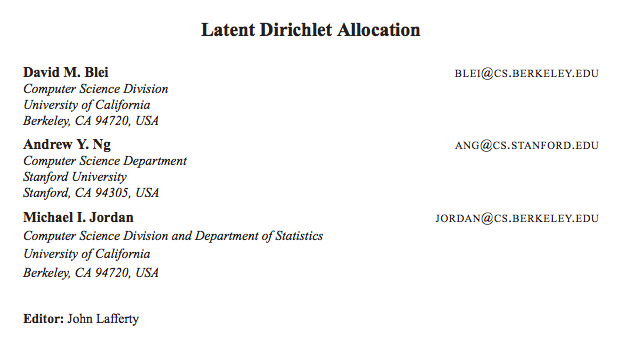
* Picture are reproduced from original paper
-
A word is the basic unit of discrete data, defined to be an item from a vocabulary indexed by $\{1,…,V\}$.
-
A document is a sequence of N words denoted by $\wb = (w_1,w_2,…,w_N)$, where $w_n$ is the nth word in the sequence.
-
A corpus is a collection of M documents denoted by $D = \{w_1,w_2,…,w_M\}$.
We wish to find a probabilistic model of a corpus that not only assigns high probability to members of the corpus, but also assigns high probability to other “similar” documents.
Latent Dirichlet Allocation
- Choose $N \sim \Poisson(\zeta)$.
- Choose $\theta \sim \Dir(\alpha)$.
- For each of the $N$ words $w_n$:
(a) Choose a topic $z_n \sim \Multinomial(\theta)$.
(b) Choose a word $w_n$ from $p(w_n \vert z_n,\beta)$, a multinomial probability conditioned on the topic $z_n$.
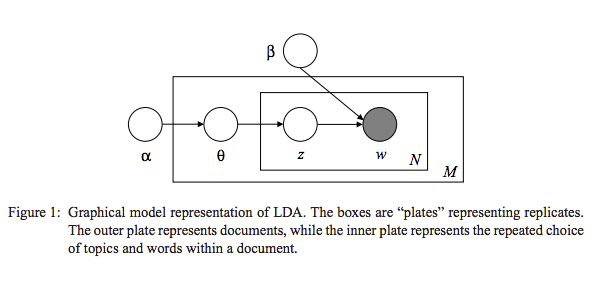
1
2
3
4
5
6
7
8
9
10
11
12
13
14
15
16
17
18
19
20
21
22
23
24
25
26
27
28
29
W = 200
D = 200
D_test = 160
K = 4
N = 50
alpha = np.array(np.linspace(0.2, 1, 4))
beta = np.random.uniform(size=(N, K)).T
beta = beta / beta.sum(axis=1)[:, np.newaxis]
data = []
topics = []
data_test = []
topics_test = []
for d in range(D):
d__ = []
theta = np.random.dirichlet(alpha, 1)[0]
for w in range(W):
z = np.random.multinomial(n=1, pvals=theta, size=1)
z_ = z.astype(bool)[0]
rand_ = np.random.uniform()
d__.append((rand_ > np.cumsum(beta[z_, :])).sum())
if d > D_test:
data_test.append(d__)
topics_test.append(theta)
else:
data.append(d__)
topics.append(theta)
topics = np.array(topics)
data = np.array(data)
1
2
3
4
5
6
7
8
9
10
11
plt.figure(figsize=(6 * 3, 6))
plt.subplot(1, 2, 1)
vals, counts = np.unique(data, return_counts=True)
plt.bar(vals, counts / counts.sum())
plt.xlabel("Word")
_ = plt.ylabel("Frequency of words \n in corpus")
plt.subplot(1, 2, 2)
plt.bar(np.arange(topics.shape[1]), topics.sum(axis=0))
plt.xlabel("Topics")
plt.xticks(np.arange(topics.shape[1]))
_ = plt.ylabel("Count")
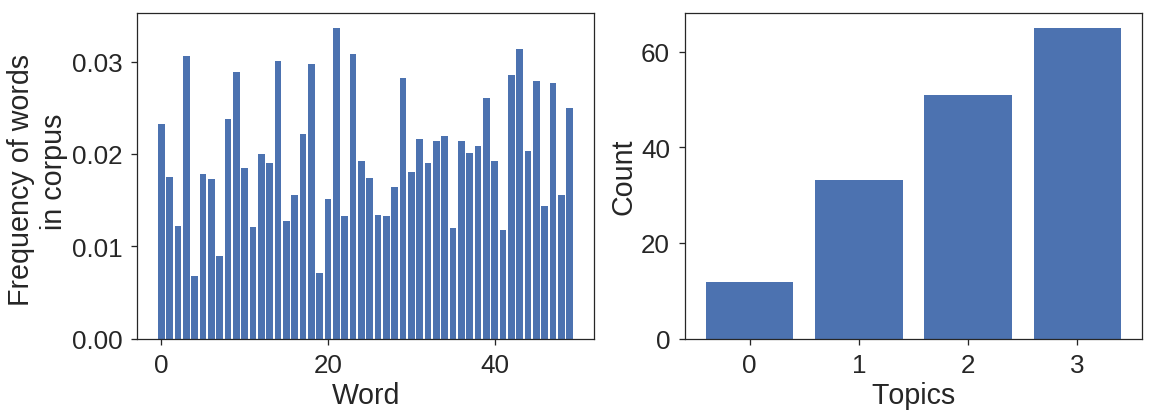
Likelihood function
Given parameters $\alpha$ and $\beta$, the joint distribution of a topic mixture $\mathbf{\theta}$, a set of $N$ topics $\mathbf{z}$, and a set of $N$ words $\mathbf{w}$ is given by:
\begin{align} p(\mathbf{\theta},\mathbf{z},\mathbf{w}\vert \alpha,\beta)=p(\mathbf{\theta}\vert \alpha)\prod_{n=1}^{N}p(z_n\vert \mathbf{\theta})p(w_n\vert z_n,\beta) \end{align}
We only observe $\wb$ while $\theta$ and $\zb$ are not observed. Integrating over $\mathbf{\theta}$ and summing over $z$, we get marginal probabilities of a document:
\begin{align} p(\mathbf{w}\vert \alpha,\beta)=\int p(\mathbf{\theta}\vert \alpha)\big(\prod_{n=1}^{N}\sum_{z_{dn}}p(z_n\vert \mathbf{\theta})p(w_n\vert z_n,\beta)\big)d\theta \end{align}
Finally the likelihood of observing a corpus is:
\begin{align} p(D\vert \alpha,\beta)=\prod_{d=1}^{M}\int p(\theta_d \vert \alpha)\big(\prod_{n=1}^{N}\sum_{z_{dn}}p(z_n \vert \theta_d)p(w_n \vert z_n,\beta)\big)d\theta_d \end{align}
Inference
We take a Bayesian perspective, and are interested in posterior distribtion after observing data.
for a given document we have:
\begin{align} p(\mathbf{\theta},\mathbf{z}\vert \mathbf{w},\alpha,\beta) = \frac{p(\mathbf{\theta},\mathbf{z},\mathbf{w}|\alpha,\beta)}{p(\mathbf{w}\vert \alpha,\beta)} \end{align}
Normalization constant in this distribution is intractable, therefore, we try other methods such as Variational Inference, Sampling or Approxiamtion.
Variational Inference
The basic idea of convexity-based variational inference is to make use of Jensen’s inequality to obtain an adjustable lower bound on the log likelihood (Jordan et al., 1999). Essentially, one considers a family of lower bounds, indexed by a set of variational parameters. The variational parameters are chosen by an optimization procedure that attempts to find the tightest possible lower bound.
Take a prticular family of variational distributions: \begin{align} q(\mathbf{\theta},\mathbf{z}|\gamma,\phi) = q(\theta|\gamma)\prod_{n=1}^{N} q(z_n|\mathbf{\phi}_n) \end{align}
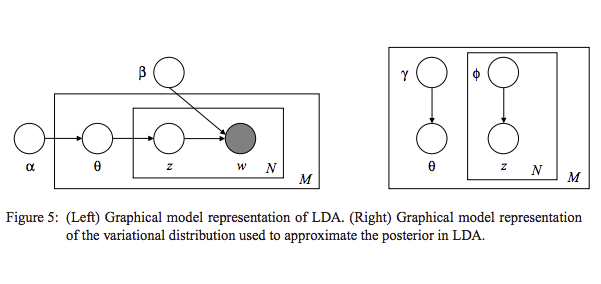
Set up an optimization problem that determines the values of the variational parameters $\gamma$ and $\phi$:
\begin{align} (\gamma^{*},\phi^{*}) = \text{argmin}_{(\gamma,\phi)} \text{D}\big[q(\mathbf{\theta},\mathbf{z}|\gamma,\phi) ||p(\mathbf{\theta},\mathbf{z}|\mathbf{w},\alpha,\beta)\big]. \end{align}
Which results in following pair of update rules:
\begin{align} \phi_{ni} \propto \beta_{iv} \exp{(\Psi(\gamma_i)-\Psi(\sum_{j=1}^{k}\gamma_i))}. \end{align}
\begin{align} \gamma_{i} = \alpha_i+\sum_{n=1}^{N} \phi_{ni} \end{align}
Derivation
\begin{align}
p(\mathbf{\theta},\mathbf{z},\mathbf{w}|\alpha,\beta)=p(\mathbf{\theta}|\alpha)\prod_{n=1}^{N}p(z_n|\mathbf{\theta})p(w_n|z_n,\beta)
\end{align}
\begin{align}
\log{p(\mathbf{w}|\alpha,\beta}) =~& \log{\int \sum_{\mathbf{z}} p(\theta,\mathbf{z},\mathbf{w}|\alpha,\beta)}d\theta \nonumber\\
=~&\log{\int \sum_{\mathbf{z}}\frac{ p(\theta,\mathbf{z},\mathbf{w}|\alpha,\beta)q(\theta,\mathbf{z})}{q(\theta,\mathbf{z})}}d\theta\nonumber\\
\geq~&\int \sum_{\mathbf{z}} q(\theta,\mathbf{z})\log{p(\theta,\mathbf{z},\mathbf{w}|\alpha,\beta)}-q(\theta,\mathbf{z})\log{q(\theta,\mathbf{z}})d\theta\tag*{Jensen’s inequality}\\
=~& \EE_q[{\log{p(\theta,\zb,\wb|\alpha,\beta})}]-\EE_q[\log{q(\theta,\zb)}] = L (\gamma,\phi;\alpha,\beta)
\end{align}
\begin{align} L(\gamma,\phi;\alpha,\beta) = \EE_q[\log{p(\theta|\alpha)}]+ \EE_q[\log{p(\zb|\theta)}]+\EE_q[\log{p(\wb|\zb,\beta)}]- \EE_q[\log{q(\theta)}] - \EE_q[\log{q(\zb)}] \end{align}
\begin{align}
L(\gamma,\phi;\alpha,\beta) &~= \log{\Gamma(\sum_{j=1}^k \alpha_j)} - \sum_{i=1}^k \log{\Gamma(\alpha_i)} + \sum_{i=1}^k (\alpha_i - 1)\big(\Psi(\gamma_i)-\Psi(\sum_{j=1}^k \gamma_j)\big)\\
&~+ \sum_{n=1}^N \sum_{i=1}^k \phi_{ni}\big(\Psi(\gamma_i) - \Psi(\sum_{j=1}^k \gamma_j)\big)\\
&~+ \sum_{n=1}^N \sum_{i=1}^k \phi_{ni}w_n^j \log{\beta_{ij}}\\
&~- \log{\Gamma(\sum_{j=1}^k \gamma_j)} + \sum_{i=1}^k \log{\Gamma(\gamma_i)} - \sum_{i=1}^k (\gamma_i - 1)(\Psi(\gamma_i)-\Psi(\sum_{j=1}^k \gamma_j))\\
&~- \sum_{n=1}^N \sum_{i=1}^k \phi_{ni}\log{\phi_{ni}}
\end{align}
Maximizing the above equation wrt to each parameter:
\begin{align}
L_{[\phi_{ni}]} =~& \phi_{ni}(\Psi(\gamma_i)-\Psi(\sum_{j=1}^{k}\gamma_i) + \phi_{ni}\log{\beta_{iv}} - \phi_{ni}\log(\phi_{ni}) + \lambda_n(\sum_{j=1}^{k} \phi_{nj} -1)\\
\frac{\partial L_{[\phi_{ni}]}}{\partial \phi_{ni}} =~& \Psi(\gamma_i)-\Psi(\sum_{j=1}^{k}\gamma_i) + \log{\beta_{iv}} - \log(\phi_{ni}) -1 + \lambda\\
\phi_{ni} \propto~& \beta_{iv} \exp{(\Psi(\gamma_i)-\Psi(\sum_{j=1}^{k}\gamma_i))}.
\end{align}
\begin{align}
L_{[\gamma_{i}]} =~& \sum_{i=1}^{k}(\alpha_i - 1)(\Psi(\gamma_i)-\Psi(\sum_{j=1}^{k}\gamma_j)) + \sum_{n=1}^{N} \phi_{ni}(\Psi(\gamma_i) - \Psi(\sum_{j=1}^{k}\gamma_j))\\
%
&-\log{\Gamma(\sum_{j=1}^{k}\gamma_j)}+\log{\Gamma(\gamma_i)-\sum_{i=1}^{k}(\gamma_i-1)(\Psi(\gamma_i)-\Psi(\sum_{j=1}^{k}\gamma_j))}\\
%%
=~& \sum_{i=1}^{k}(\Psi(\gamma_i)-\Psi(\sum_{j=1}^{k}\gamma_j)(\alpha_i + \sum_{n=1}^{N}\phi_{ni}-\gamma_{i})-\log{\Gamma(\sum_{j=1}^{k}\gamma_j)}+\log{\Gamma(\gamma_i)}\\
%
\frac{\partial L_{[\gamma_{i}]}}{\partial\gamma_{i}} =~& \Psi’(\gamma_i)(\alpha_i + \sum_{n=1}^{N}\phi_{ni}-\gamma_{i})-\Psi’(\sum_{j=1}^{k}\gamma_j)\sum_{j=1}^{k}(\alpha_j + \sum_{n=1}^{N}\phi_{nj}-\gamma_{j})\\
\gamma_{i} =~& \alpha_i+\sum_{n=1}^{N} \phi_{ni}
\end{align}
Experiments
1
2
3
4
5
6
7
alpha0 = np.ones(K)
phi = np.zeros((data.shape[0], data.shape[1], K))
phi[:, :, :] = 1 / K
gamma = np.zeros((data.shape[0], K))
gamma[:, :] = alpha + phi.shape[0] / K
beta0 = np.random.uniform(size=(K, N))
beta0 = beta / beta.sum(axis=1)[:, np.newaxis]
1
2
3
4
5
6
7
8
9
10
11
12
13
14
15
16
17
18
19
20
21
22
23
24
25
26
27
28
29
30
31
32
33
34
35
36
37
38
39
40
41
42
43
44
45
46
47
48
49
50
51
52
53
54
55
56
57
def L(phi, gamma, beta0, alpha0):
temp = 0
for m in range(phi.shape[0]):
ss = sp.special.digamma(gamma[m, :]) -\
sp.special.digamma(gamma[m, :].sum())
temp = sp.special.loggamma(
alpha0.sum()) - sp.special.loggamma(alpha0).sum() + ((alpha0 - 1) * ss).sum()
temp += (phi[m, :, :] * ss).sum()
temp += (phi[m, :, :] * beta0[:, data[m, :]].T).sum()
temp += -sp.special.loggamma(gamma[m, :].sum()) + sp.special.loggamma(
gamma[m, :]).sum() - ((gamma[m, :] - 1) * ss).sum()
temp += (-phi[m, :, :] * np.log(phi[m, :, :])).sum()
return np.real(temp)
def update_vi(phi, gamma, beta0, alpha0):
m = 0
history = []
iter_ = 0
beta = beta0.copy()
while(True):
phi_temp = phi.copy()
gamma_temp = gamma.copy()
for m in range(phi.shape[0]):
for n in range(phi.shape[1]):
for i in range(gamma.shape[1]):
phi_temp[m, n, i] = beta[i, data[m, n]] * np.exp(sp.special.digamma(gamma[m, i]) -\
sp.special.digamma(gamma[m, :].sum()))
phi_temp[m, :, :] = phi_temp[m, :, :] /\
phi_temp[m, :, :].sum(axis=1)[:, np.newaxis]
for m in range(gamma.shape[0]):
for i in range(gamma.shape[1]):
gamma_temp[m, i] = alpha0[i] + phi_temp[m, :, i].sum()
diff_gamma = np.mean((gamma_temp - gamma)**2)
diff_phi = np.mean((phi_temp - phi)**2)
if ((diff_phi < 1e-3) & (diff_gamma < 1e-3)):
break
phi = phi_temp
gamma = gamma_temp
L_ = L(phi, gamma, beta, alpha0)
print("diff gamma %f" % diff_gamma, "diff phi %f" %
diff_phi, "L %f" % L_)
history.append((beta, phi, gamma, L_))
iter_ += 1
return phi, gamma, beta, iter_, history
1
2
3
4
5
6
7
8
9
new_phi, new_gamma, new_beta, iter_, history = update_vi(
phi, gamma, beta0, alpha0)
diff_gamma = np.mean(np.abs(new_gamma - gamma))
diff_phi = np.mean(np.abs(new_phi - phi))
diff_beta = np.mean(np.abs(new_beta - beta))
print("iter", iter_)
print("diff gamma %f" % diff_gamma, "diff phi %f" % diff_phi)
print("diff beta %f" % diff_beta)
diff gamma 133.635209 diff phi 0.014895 L -23.776968
diff gamma 25.256380 diff phi 0.000735 L -23.141265
diff gamma 22.212411 diff phi 0.000636 L -22.511695
diff gamma 18.884462 diff phi 0.000534 L -21.896922
diff gamma 15.560183 diff phi 0.000436 L -21.305556
diff gamma 12.495897 diff phi 0.000349 L -20.745106
diff gamma 9.842222 diff phi 0.000274 L -20.221272
diff gamma 7.646850 diff phi 0.000213 L -19.737676
diff gamma 5.888301 diff phi 0.000164 L -19.295954
diff gamma 4.510381 diff phi 0.000126 L -18.896069
diff gamma 3.446265 diff phi 0.000097 L -18.536718
diff gamma 2.631902 diff phi 0.000074 L -18.215718
diff gamma 2.011879 diff phi 0.000057 L -17.930349
diff gamma 1.540939 diff phi 0.000044 L -17.677624
diff gamma 1.183386 diff phi 0.000034 L -17.454480
diff gamma 0.911664 diff phi 0.000026 L -17.257917
diff gamma 0.704776 diff phi 0.000020 L -17.085083
diff gamma 0.546850 diff phi 0.000016 L -16.933323
diff gamma 0.425937 diff phi 0.000012 L -16.800206
diff gamma 0.333056 diff phi 0.000010 L -16.683532
diff gamma 0.261459 diff phi 0.000008 L -16.581325
diff gamma 0.206069 diff phi 0.000006 L -16.491823
diff gamma 0.163057 diff phi 0.000005 L -16.413463
diff gamma 0.129534 diff phi 0.000004 L -16.344865
diff gamma 0.103307 diff phi 0.000003 L -16.284812
diff gamma 0.082711 diff phi 0.000002 L -16.232234
diff gamma 0.066476 diff phi 0.000002 L -16.186193
diff gamma 0.053631 diff phi 0.000002 L -16.145866
diff gamma 0.043431 diff phi 0.000001 L -16.110535
diff gamma 0.035300 diff phi 0.000001 L -16.079568
diff gamma 0.028795 diff phi 0.000001 L -16.052417
diff gamma 0.023572 diff phi 0.000001 L -16.028601
diff gamma 0.019363 diff phi 0.000001 L -16.007698
diff gamma 0.015959 diff phi 0.000000 L -15.989344
diff gamma 0.013197 diff phi 0.000000 L -15.973218
diff gamma 0.010948 diff phi 0.000000 L -15.959041
diff gamma 0.009111 diff phi 0.000000 L -15.946569
diff gamma 0.007605 diff phi 0.000000 L -15.935589
diff gamma 0.006366 diff phi 0.000000 L -15.925916
diff gamma 0.005344 diff phi 0.000000 L -15.917387
diff gamma 0.004498 diff phi 0.000000 L -15.909861
diff gamma 0.003796 diff phi 0.000000 L -15.903213
diff gamma 0.003211 diff phi 0.000000 L -15.897338
diff gamma 0.002723 diff phi 0.000000 L -15.892138
diff gamma 0.002315 diff phi 0.000000 L -15.887534
diff gamma 0.001972 diff phi 0.000000 L -15.883451
diff gamma 0.001683 diff phi 0.000000 L -15.879829
diff gamma 0.001440 diff phi 0.000000 L -15.876610
diff gamma 0.001234 diff phi 0.000000 L -15.873747
diff gamma 0.001059 diff phi 0.000000 L -15.871198
iter 50
diff gamma 40.601717 diff phi 0.232107
diff beta 0.000000
1
2
3
4
5
6
7
8
9
10
11
12
13
14
15
16
vals = []
val_name = []
val_exp = []
val_unit = []
for ind, h in enumerate(history):
t = np.abs(h[2] / h[2].sum(axis=1)[:, np.newaxis] - topics)
vals.extend(t.flatten().tolist())
val_name.extend(['$\\bar{\\gamma}-\\theta$'] * t.shape[0] * t.shape[1])
val_exp.extend([ind] * t.shape[0] * t.shape[1])
val_unit.extend(np.arange(t.shape[0] * t.shape[1]))
l = np.exp(h[3])
vals.extend([l])
val_name.extend(['$L$'])
val_exp.extend([ind])
val_unit.extend([0])
1
2
3
4
import pandas as pd
df = pd.DataFrame(data={"vals": vals, "param": val_name,
"exp": val_exp, "unit": val_unit})
1
2
3
4
5
6
7
8
9
10
11
g = sns.factorplot(data=df, x="exp", y="vals",
row="param", sharey=False, aspect=3).set_titles("{row_name}")
g.axes[0, 0].set_ylabel(g.axes[0, 0].get_title())
g.axes[1, 0].set_ylabel(g.axes[1, 0].get_title())
g.axes[0, 0].set_title("")
g.axes[1, 0].set_title("")
g.axes[1, 0].grid("on")
g.axes[0, 0].grid("on")
g.axes[0, 0].set_xticks(np.arange(0, len(history), 5))
g.axes[0, 0].set_xticklabels(np.arange(0, len(history), 5))
plt.xlabel("iteration")
<matplotlib.text.Text at 0x7fde04dfa5c0>
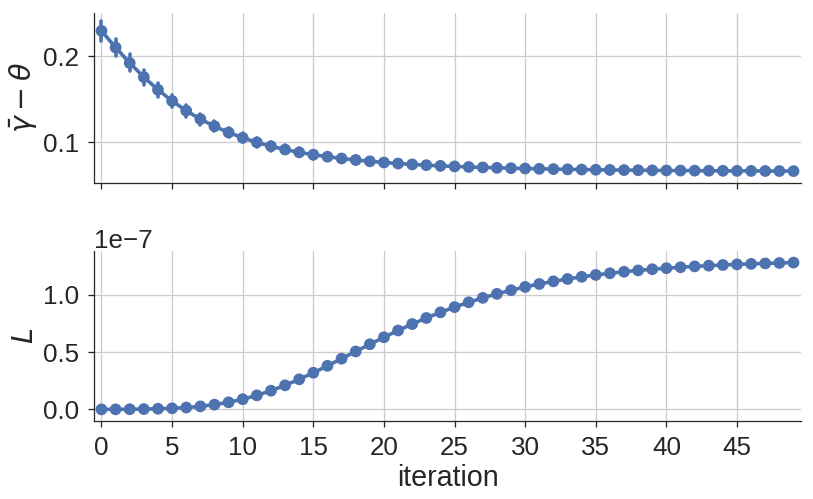

Leave a Comment